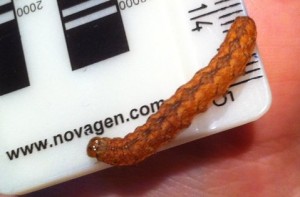Its hard to believe that I have now been doing my apprenticeship for over two months, although looking back I’ve already learned a lot.
I was lucky to get the chance to visit the Scottish Museums entomology collection. A tour of the collections really shows how diverse insect life is in the UK as well as abroad. Some were amazingly large and colourful, like the tropical beetles and butterflies, while others were no larger than a full stop. I will hopefully return with my own specimens, which I can check against the reference collection.
I’ve been busy visiting brownfield sites listed on the Vacant and Derelict Land Register to assess which have habitat features that are likely to support a good variety of bugs. Site visits have taken me right around the Inner Forth from Stirling to Bo’ness and around Kincardine and Alloa on the other side. Visiting a site for the first time is always exciting; you never know what you’re going to come across. Some are disappointments when you arrive and find that it has now been developed but there are a few unexpected little gems out there to be found too. I probably look like a lost tourist as I take photos of some of the less visited sights of the Inner Forth. I’ve seen some nice wildlife on my travels as well. Although most bugs are hidden away during colder weather, other wildlife I’ve come across has included secretive Snipe and a flock of colourful Scandinavian Waxwings. I was also surprised to see the long ears of a Brown hare on one of my wilder sites. So there’s plenty to see before bugs become more active again when the weather warms up.
One of my most memorable visits was to a Bing (mining spoil heap) near Stirling with TCV volunteer Heather and Scott from Buglife. The Bing forms an interesting landscape with steep sides and a wet crater-like centre. Heather spotted a caterpillar tucked away underneath birch bark. Scottish Moths forum members helped identify it as a Grey Arches Polia nebulosa caterpillar, which is uncommon in this area.

- Grey Arches Polia nebulosa caterpillar
So a good find, by Heather! It spends the winter as a caterpillar and will emerge as an adult from around June. Another species we came across was the Strawberry snail Trochula striata, which incredibly, is actually hairy when looked at under magnification.
I’m now starting to see how a great variety of former land uses can come under the term ‘brownfield’ including a former power station, a derelict country mansion and cleared site of a former hospital and a former tannery to list a few. Most surreal of all was my visit to a disused army munitions store, which has well spaced out buildings and blast shelters in case of accidents. Now the area is deserted apart from the odd sheep and could easily be the set of a low budget horror film.
I have also had the opportunity to momentarily divert my attention away from bugs and delve into the fascinating world of lichens. In November I attended a Lichen Identification course taught by a previous Natural Talent Apprentice. We started by getting the lichen groups sorted out into jam tarts and beardy ones. Then we went out into the field to see what we could discover. Some lichens are very pollution sensitive and it was interesting to see how some are just starting to return to the tips of trees now that most of the heavy industry has declined in this area.
Just before Christmas I got the chance to meet all my fellow apprentices while we did our first aid and risk assessment training, so I’m ready for a safe start to the new year.
I’m now looking forward to choosing my sites to survey in more detail and deciding which groups I want to focus on learning to identify.
Bye for now
Niall, Urban Biodiversity Apprentice
